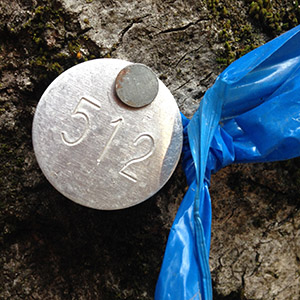The most important part of ensuring that tools will not spread SOD is to be sure that no organic debris or soil is present on the tools. This applies to all portions of each tool, including parts that may not be visible (like the return of a chain in a chainsaw or the interior of a tree chipper). For more information on cleaning tools and equipment, go to https://nature.berkeley.edu/garbelottowp/?p=1208.
When treating oak trees with phosphites to help prevent SOD, it may be beneficial to apply the topical treatment to bark that is dry. Rain occurring after the treatment (even immediately after) does not affect the application. If injecting phosphites, it may be better to avoid rainy days, as lower evapotranspiration is often documented for trees in such conditions. Lower evapotranspiration rates may result in poor tree absorption of phosphites.
Note: Topical treatments are most effective when applied in the fall, from November to early December. Injections should only be performed from fall to early winter.
When trying to determine if an oak may have SOD (caused by the plant pathogen Phytophthora ramorum), the first step is to determine if the tree lies within 1 km of a known outbreak. This can be done by accessing SODMAP at www.sodmap.org or by uploading the free “SODMAP Mobile” app to your smartphone. Stand next to the tree in question and tap the risk button. A response of moderate or high risk would suggest Phytophthora ramorum may be present. The next step is to confirm it is indeed P. ramorum. Make sure the oozing is not wetwood, or bacterial flux, which typically is associated with much more oozing and often has an unpleasant odor. Bacterial flux usually has a watery secretion running down the trunk that originates from a wound or branch crotch. If all symptoms align with SOD, the next step is to test for P. ramorum. If a symptomatic California bay laurel tree is within 10 m of the oak, collect symptomatic bay leaves for testing. This is not a definite diagnosis for the oak, but it may be an acceptable one that does not involve wounding the oak tree for sampling. Bay-based diagnosis for an oak may be less accurate after multiple years of drought, as bays may actually turn from SOD positive to SOD negative during extended dry conditions. One can get bay leaves tested by participating in one of the annual SOD blitzes (www.sodblitz.org) or by submitting samples to the California Department of Food and Agriculture. Testing the oak requires debarking a portion of the tree until the margins of the putative SOD lesion under the bark are visible and then plating the margins of the lesion on Phytophthora-selective medium for laboratory analysis.
SOD Blitzes include a training session for blitz volunteers on SOD and proper sampling, followed by time in the field for collecting and marking sample locations. All necessary collection materials are provided to volunteers during the training session for use either the same day of the training or the day after. All samples are to be dropped off at a designated location (location announced at the training session). There are approximately 20 SOD Blitzes in areas of California that have sudden oak death or at risk of disease establishment. Most of the training sessions are offered on Saturday mornings. SOD Blitz schedules for the coming year are posted annually during the last week of January at www.sodblitz.org.
Leaf tip scorch symptoms on redwood trees are found from the lower to upper canopy and include healthy leaves interspersed with brown and grey leaves or portions of leaves. Grey leaves typically have black margins into the healthy tissue.
Such symptoms are typically caused by a fungus called Pestalotiopsis funerea. They are commonly associated with drought, when rainfall occurs or when there is overhead watering around the tree. Drought stress predisposes plants to being infected, so the increased moisture facilitates the infection process. Normally the fungus will only seriously affect sprouts, as branches of adult tress will regrow areas killed by the infection within a year. In nursery settings it is important to increase ventilation and avoid big differences in watering regimes to minimize symptoms.
Injections may be better for large trees with a regular shape, while topical applications may be better for large, irregular, gnarly trees.
If SOD phosphite treatments are being applied by injection November 1st – December 15th, data has shown that treating every 2 years is sufficient. When preparing the injections, be sure to use the most current dosage recommendations as they have recently been updated. Current recommendations can be found at http://nature.berkeley.edu/garbelottowp/?page_id=2345. The new dosages are significantly more diluted than the original label dosages, yet are just as effective and cause almost no damage to the wood (the original label dosages do cause some wood damage).
If SOD phosphite treatments are being applied using a topical bark application, treat every 1 – 2 years. While data has shown that topical applications last for 18 months, fall treatments are the most effective. Therefore, in a county known to be infested, treat trees in riparian areas, within 20 miles of the coast, or within 2 miles of redwood forests every year. Treat trees in drier areas (of infested counties) every 2 years.
Yes, you can apply phosphonate to your oak trees to help protect them from sudden oak death. You can find it in many Bay Area garden supply stores.
If you apply it topically to the bark, you will also need the surfactant Pentra-Bark® and you will need a sprayer. If you choose to inject it, you will need enough injectors to treat your largest tree (1 injector every 6 inches around the circumference). Treatments should be applied between November 1st and December 15th for best results.
For details on how to apply phosphonates, go to www.matteolab.org, “Treatment and Diagnosis” (at top of page).
The revised SOD treatment recommendations can be found at: https://nature.berkeley.edu/garbelottowp/?p=1039.






